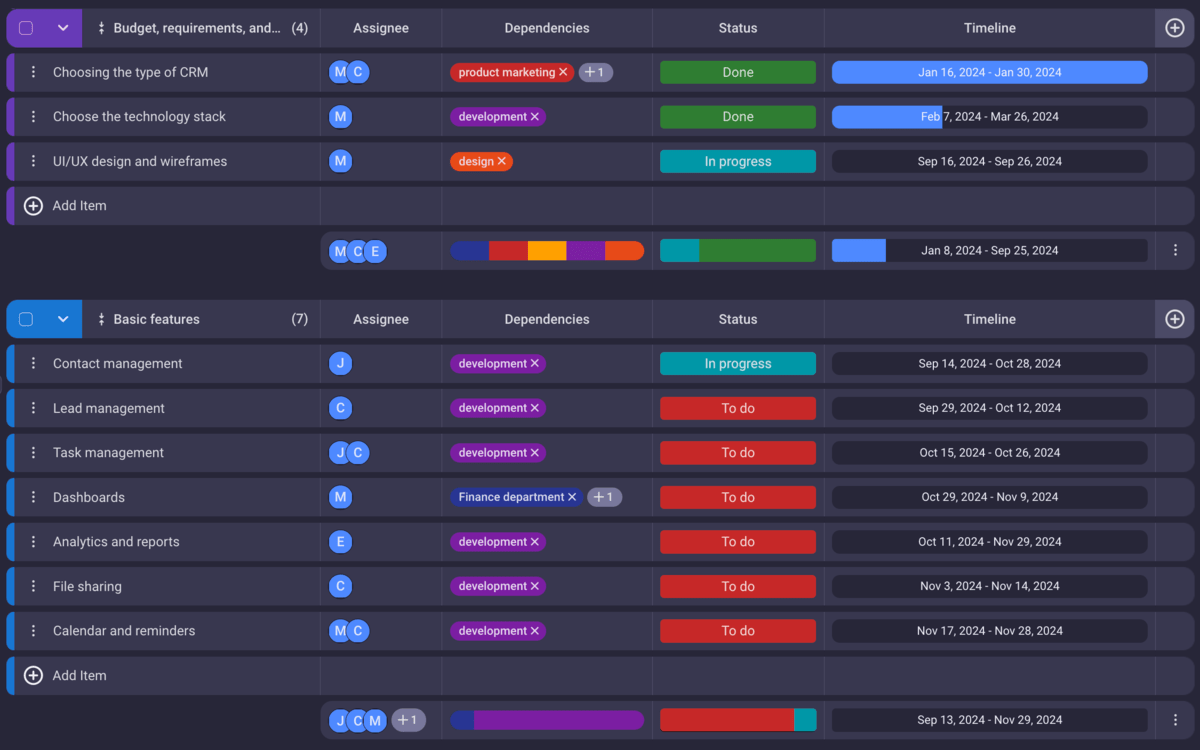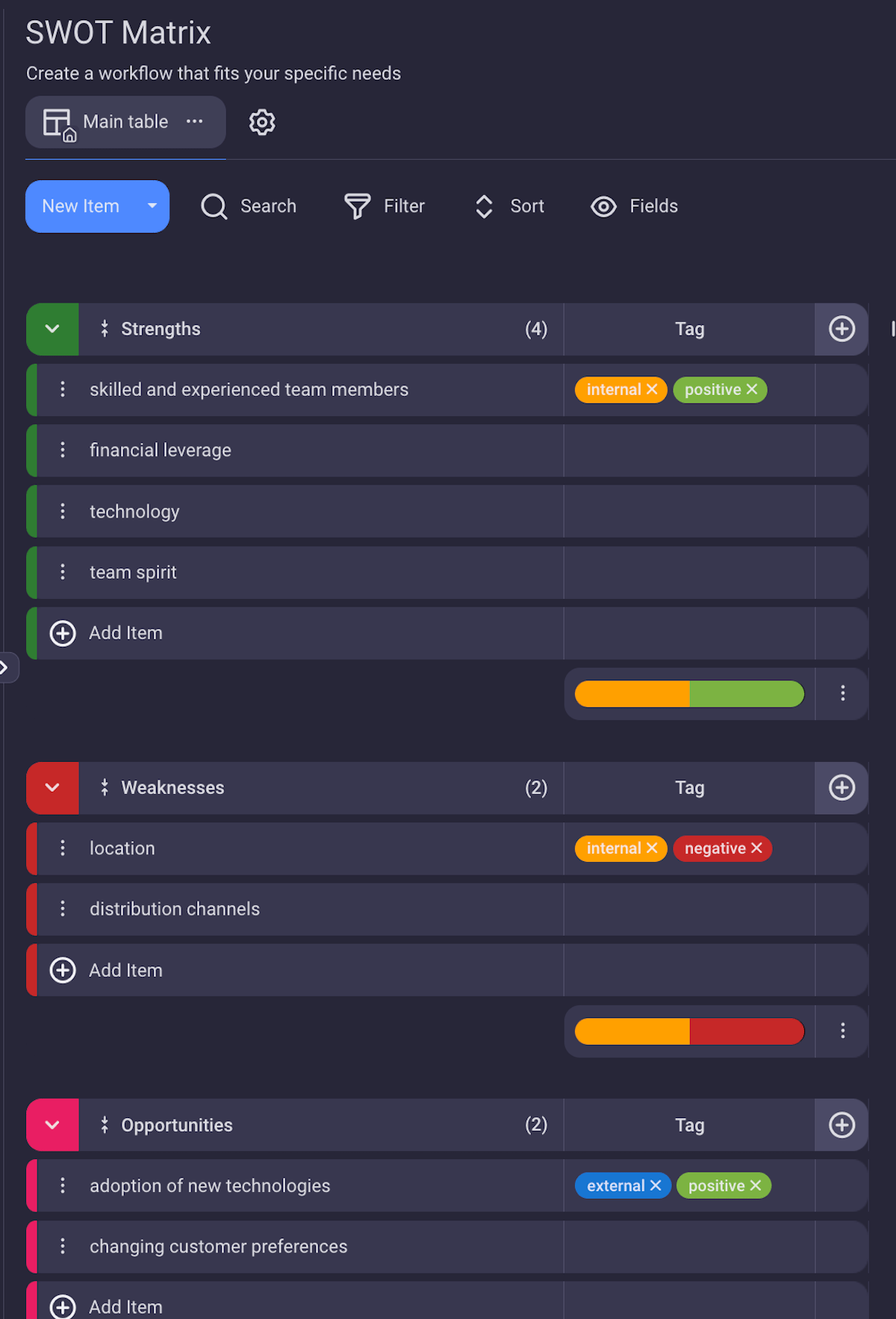How stress-free would it feel if your project didn’t have competition? Or if you didn’t need to worry about funding, PR, or politics?
Even if you took away these external factors, you’d still have to think about employee well-being or budgeting. The worries around managing a project in a complex environment are many.
Yet, all of these factors can also help your project management. Politics can control competition, and PR can boost your success with customers.
A project cannot exist in a vacuum. Therefore, the best way to overcome your worries is to understand these factors better.
The project environment includes all factors that, directly or indirectly, externally or internally, influence your project.
In this article, we will take a look at these factors, as well as the methods — like SWOT analysis — that will help us discern and take advantage of the factors.

In this article:
What are the types of project environments?
Many specifics might affect your project. We call these project environment factors.
Now, since there are plenty of these factors, we need to classify them in some way so that you can more easily analyze them.
Usually, we distinguish between 2 project environment types, which work as groups of factors with unifying characteristics:
- External project environment
- Internal project environment
Type #1: External environment
The external project environment is made up of all the factors that are not under the direct control of your organization. Even though these factors exist outside your project, they can have a great influence on it.
The external environment can further be divided into:
- Microenvironment
- Macroenvironment
Subtype #1: Microenvironment
The microenvironment includes all the external factors that have a direct influence on the project. It involves the following factors:
- Consumers,
- Suppliers,
- Physical distribution agencies,
- Marketing agencies,
- Financial institutions,
- Competitors, and
- The public eye.
Microenvironment factor #1: Consumers
If your project focuses on selling a product or a service, it is in a market connection with consumers.
Your task, as a project manager, is to track the relationship between your organization and consumers in your chosen market.

Microenvironment factor #2: Suppliers
Suppliers are an important factor because they provide the necessary resources for your project.
You must stay on good terms with your suppliers and find new ways to boost those relationships. Building a great working relationship with your suppliers leads to:
- Information on the market’s supply,
- Finding new ways of obtaining valuable resources, and
- Even reducing supply costs.
Microenvironment factor #3: Physical distribution agencies
Physical distribution agencies offer the service of storing and transporting goods. They can transport your goods by railroad, freight, etc.
For example, if your shipment is late, it can affect your deadlines, so choosing a trusted distribution agency is essential.
Microenvironment factor #4: Marketing agencies
Marketing agencies can help increase awareness of your project through the following services:
- Market research,
- Education,
- Consulting,
- Content marketing,
- PPC, etc.
Since many organizations rely on outsourced marketing services, it’s important that you hold your marketing agency of choice under strict standards and criteria.
Microenvironment factor #5: Financial institutions
Through their financial services, banks and insurance companies directly influence your project’s business transactions. Therefore, it’s crucial to foster great collaboration and cooperation with these institutions.
Microenvironment factor #6: Competitors
Competitors should be identified even before you begin with your project. You should closely monitor and study your competitors in order to gain a better position in the market by finding ways to outperform them.
Microenvironment factor #7: The public
The public includes all market subjects that cannot be sorted into the previously mentioned groups, but still have an interest in your project. This interest can be positive, but also negative and even hostile.
We can separate the public into the following groups:
- The financial public — has an essential influence in obtaining financial support.
- Media — social media, internet blogs, TV and radio stations, magazines, etc.
- State — communication with the state government, agencies, the local government, etc.
- People — a unique focus group of organizations and associations. For example, organizations for consumer protection or anti-smoking organizations. Depending on your project, these can greatly influence your organization.
Subtype #2: Macroenvironment
The macroenvironment includes all external factors that do not have a direct influence on your project. However, they influence the market as a whole and therefore have an indirect impact on your project management.
The macroenvironment factors are:
- Demographic,
- Market,
- Technology,
- Politics,
- Nature, and
- Culture.
Macroenvironment factor #1: Demographic
The demographic information usually focuses on your target demographic group. It deals with information such as:
- Population count,
- Population growth,
- Average age,
- Average income, etc.
For example, if you’re building a product, it’s important to know your target audience and their needs. If you’re making a collaborative note-taking app, you might want to target students and young professionals.
On the opposite end, if you’re making a high-end luxury product, you will want to target a more high-income demographic.
Macroenvironment factor #2: Market
Before you decide to realize your idea for a product or service, you first need to research the market and the viability of your product or service considering the current market conditions.
Through market research, you gain insight into:
- Inflation rates,
- Income changes,
- Purchasing power,
- Purchasing habits, etc.
For example, if inflation rates increase, the purchasing power of a populace decreases.
Alternatively, you might need to pay attention to whether the purchasing habits of a population fit into the niche that your project is attempting to produce.
Macroenvironment factor #3: Technology
Overall improvements to a market’s technology can greatly impact and improve the way your project is executed.
With new technology comes:
- Increased efficiency,
- Modernization,
- New discoveries,
- Materials,
- Products, and
- Markets.
Let’s look at an example that explains why technology is an important macroenvironment factor.
Uber didn’t invent either the phone or the internet. Yet, without that technology, they wouldn’t have been able to compete with your average taxi service.
Macroenvironment factor #4: Politics
The political environment consists of:
- Laws,
- Regulations, and
- Policies your project must follow.
Laws and regulations may seem limiting at first, but they can actually work in your favor, preventing things like monopolies from forming in the market.
They can also be restricting — a tax increase can take away financial resources from your project.
Overall, it’s important to keep track of any changes in this department, as they might affect your project.
Macroenvironment factor #5: Nature
When you think of nature as a factor, the first thing that comes to mind is natural resources. And, if your project doesn’t have any use for them, you might wish to skip this factor in your analysis.
Be careful though — another important part of this factor is the change in energy costs, which affects practically everyone.
Macroenvironment factor #6: Culture
While the demographic factor deals with more easily quantifiable information, culture deals with something more abstract.
When analyzing culture, pay attention to:
- People’s values and beliefs,
- Community experiences,
- Religious structure, etc.
All of these can greatly affect how the target populace will react to your project.
Type #2: Internal environment
Internal environment refers to all the factors that come from within your project. Therefore, they are in your more immediate control.
Internal factor #1: Organizational culture
This is arguably one of the most important factors in your project management. It can affect things like:
- Employee morale,
- Quality standards,
- Product quality,
- Project team efficiency, etc.
We can describe it as the cumulation of your vision, mission, objectives, and company value system, as well as the “Code of Conduct”, i.e. the way your company culture is enacted in practice.
A toxic company culture can have a negative impact on your project team morale and engagement, hurting the entire project in the long run.
💡 PLAKY PRO TIP
Another danger for companies and team morale is silo mentality. Find out more about what it means to work in silos and the problems it inspires below:
Internal factor #2: Organizational structure
Organizational structure represents the way activities are directed within an organization as well as the hierarchical outline within which your organization operates. It can influence things like:
- Risk aversion,
- How tasks are delegated and executed, as well as
- Interpersonal employee relationships.
It’s important to have a clearly defined structure. If not, an employee reporting progress to the wrong person can cause delays.
Alternatively, confusion in task delegation can lead to multiple employees working on the same task.
Internal factor #3: Human resources
Your employees are a vital part of your internal environment. They are a large part of what propels your project from idea to reality.
To make the most of their project, project managers should track their team members’ skills, performance, and attitude toward work.
Even things that are not directly project-related — such as, for example, a colleague who tends to start conflicts — can worsen the organizational culture and negatively influence the project outcome.
Internal factor #4: Financial resources
This factor affects your project budget and the way your budget is distributed within your project.
The available financial resources will affect your project planning, as you need to make sure your ideas are realistic within the budget constraints.
Internal factor #5: Tangible assets
Tangible assets are physical resources that your organization owns. This can be anything from office desks and computers to the office building itself.
Having a detailed knowledge of your physical assets will allow you to use them for your project most effectively.
For example, if you have a limited amount of necessary machinery, you must take that into account while planning out your project.
Internal factor #6: Project management software
We mentioned earlier that advances in technology could improve the way projects are executed. One of the biggest improvements brought to us this way is project management software.
With free project management apps like Plaky, tracking your project progress and overall task management has never been easier.
Much like spreadsheets replaced pin-up boards, PM software is quickly replacing spreadsheets. The right project management software can improve your efficiency, help your team stay on track, and allow you to have all the information you need in one place.


What is a project environment analysis?
Project environment analysis is a way of translating all the information you’ve gathered about your project environment factors and turning it into a strategy that will take your project’s results to greater heights.
It’s not guaranteed that all of the mentioned project management factors will influence your work. However, through careful analysis, you can discern the ones that are most likely to affect your project.
Project environment analysis methods
The task of a project environment analysis is to determine a project’s potential and enable its adaptation in an ever-changing environment.
There are plenty of methods to conduct a project environment analysis that have been tried and tested over time. Here, we’ve listed 5 of the most popular ones:
- SWOT analysis,
- PEST analysis,
- Porter’s value chain,
- Porter’s five forces, and
- Stakeholder analysis.
We’ll briefly go over each of them.
Method #1: SWOT analysis
This method focuses on analyzing both the internal and external environment of your project. The SWOT analysis is used to get an idea of where your project stands in its environment and what strategies you should implement in the future based on these insights.
SWOT is an acronym that stands for the most important internal and external factors that influence your project, i.e. your project’s:
- Strengths,
- Weaknesses,
- Opportunities, and
- Threats
Identifying your project’s strengths & weaknesses
Project strengths and weaknesses belong to the internal project environment factors.
To determine the strengths and weaknesses of your project there are 2 questions to ask yourself:
- What are the properties of your project that make it stand out from the competition?
- What are the unfavorable circumstances and limitations within the project?
For example, producing almond milk has the strength of being able to use the leftover dried parts for sweet cake production.
Alternatively, a weakness could be a lack of funding for that project.
Identifying your project’s opportunities & threats
Conversely, opportunities and threats are external project environment factors. To determine what exactly they are, we may ask the following questions:
- What are the opportunities and positive effects that the external project environment offers us?
- What are the outside dangers and threats to our project?
For example, things like the launching of a new technology can be seen as an opportunity, and competitors creating a monopoly on the market would be seen as a threat.

Method #2: PEST analysis
The PEST analysis is a project environment analysis focused on the essential external environment factors.
The acronym itself stands for these 4 factors, which we explored in more depth earlier in the article:
- Politics,
- Economy,
- Society, and
- Technology.
Garnering a better understanding of your external environment will help you position yourself in the market correctly.
As another benefit, improving relationships with these factors will always benefit you in the long run, opening new avenues and opportunities.
Method #3: Porter’s value chain
In contrast to PEST, you can use Porter’s value chain for internal environment analysis.
It’s an analysis of the possible activities and processes within your project, with the intention of increasing overall efficiency.
Porter’s value chain separates all activities in a project into two categories:
- Primary and
- Support activities.
Primary activities in the Porter’s value chain
Primary activities are those that directly relate to creating, selling, maintaining, and supporting your project’s product or service.
They include:
- Inbound logistics,
- Operations,
- Outbound logistics,
- Marketing and sales, and
- Service.
Secondary activities in the Porter’s value chain
The function of the secondary activities is to support the primary activities.
Secondary activities are:
- Procurement and purchasing,
- Human resource management,
- Technology development, and
- Company infrastructure.
Having a better understanding of the intricacies of your project’s activities gives way to more creative improvement tactics.
Seeing how activities interact with each other and how to better delegate cooperation between them can yield fantastic results.
Method #4: Porter’s five forces
When thinking of moving your project into a new environment, you can use Porter’s five forces analysis to calculate the competitive environment.
Let’s take a look at the 5 forces that determine this and the main questions you should ask when analyzing them:
- The threat of new entry — How easy is it for new projects to enter this market?
- Buyer’s bargaining power — How easy is it for buyers to switch to competitors?
- Supplier’s bargaining power — How difficult is it for you to switch suppliers?
- The threat of substitution — How easy is it to find a replacement for what you offer?
- Competitive rivalry — How many competitors do you have, and how strong are they?
Answering these questions brings an avalanche of conclusions that will tell you if a competitive environment is worth entering or not.
For example, if it is difficult for you to switch suppliers, supplier power is high. Because of this, suppliers can easily and unpredictably change their prices or the quality of their products or services. This is not an environment worth entering.
On the other hand, if you offer a product or service that is difficult to replace, you will have a low threat of substitution. This means it is difficult for buyers to divert from what you offer and makes this an attractive environment to enter.
Method #5: Stakeholder analysis
Stakeholders are any individuals, groups, or organizations that have an interest in the realization of your project, and can exert influence over it. As the name suggests, they “hold the stakes” to your project and its success.
We can separate project stakeholders into 2 main categories, based on where they stand in our project environment factors — they can be internal and external.
Internal stakeholders are:
- Shareholders,
- Managers,
- Project managers, and
- The project team.
External stakeholders are:
- Business partners,
- Clients,
- Suppliers,
- The government, etc.
Stakeholder analysis is done in five steps:
- Identify and classify stakeholders.
- Analyze and infer specific stakeholders’ interests.
- Analyze and infer specific stakeholders’ possible influence.
- Define priority stakeholders with the greatest influence.
- Find a way of gaining support from the priority stakeholders.
Prioritizing support from stakeholders with the greatest influence on your project is the most efficient way of gaining better results.
Conclusion: Being aware of your project environment improves your chances of success
As mentioned, you can’t escape your project environment, so it’s always best to understand it. Whether you use one of the mentioned methods or try to improvise your own, the underlying concepts stay the same.
If you want to become more aware of your project environment and understand how it affects your project, we encourage you to try some of the methods we listed.
Go through the project environment analysis methods, and see how different ones bring different advantages. You could analyze an existing project you are familiar with.
Just like with everything else, in project management, practice makes perfect.
✉️ Has this post helped you understand the project environment? Have you analyzed a project environment before? Let us know at blogfeedback@plaky.com, and we may include your answers in this or future posts. If you liked this blog post and found it useful, share it with someone you think would also benefit from it.
